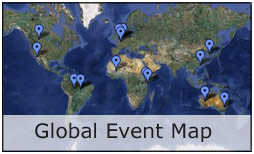The World Migratory Bird Day Team Is Pleased to Be Able to Launch the 2012 Website and Poster!
Bonn, 14 March 2012 - Each year on the second
weekend in May, dedicated people and organizations plan
World Migratory Bird Day events to celebrate migrating
birds in their region and to raise awareness about the
need for their protection. Since World Migratory Bird
Day began in 2006, events have been carried out in 104
countries and we hope this year even more people and
countries will join the global celebration.
On their epic journeys spanning thousands of kilometres,
migratory birds connect continents, cultures and people
along their migration routes. World Migratory Bird Day
2012 and this year’s theme "Migratory birds
and people - together through time" highlight the vital relationship
between birds and people.
Considering the cultural, social, historic, economic
and spiritual connections we have with birds, it becomes
clear that migratory birds and people are inseparably
connected in many different ways and on many different
levels. At the same time, many human activities including
excessive land use and unsustainable hunting, as well
as the impacts of climate change, fishing by-catch and
pollution gravely threaten migratory bird populations
around the world.
This year’s poster
portrays the 2012 World Migratory Bird Day theme "Migratory
birds
and people – together through time", highlighting
the many connections and historic links between migratory
birds
and people in a truly global way. Humanity’s fascination
with migratory birds is evident in the symbolism throughout
history in many ancient cultural legends. For example,
in Egypt the ancient falcon-headed god Horus and in Peru
the
Nazca line monuments are testaments to migratory birds’
strong influences on past cultures. Also, many groups and
cultures continue to rely economically on migratory birds
for their livelihoods, for example through subsistence
and the growing global ecotourism and birdwatching industry.
The phenomenon of bird migration
is crucial to the web of life, as migrating birds act as
indicators of biodiversity, ecosystem health and climate
change. Migratory birds also provide essential ecological
benefits and services, such as pollination, to the ecosystems
we rely on to survive.
We are pleased to offer this
year’s poster in English, French, Spanish and German
and free poster packages can be ordered by organizers to
support and help promote their events. You can register
your events and order posters on the new 2012 World Migratory
Bird Day Website at:
www.worldmigratorybirdday.org
Support migratory birds
through an event!
 Join
Join
the celebration of a great natural wonder on World Migratory
Bird Day! We invite everyone to join us to celebrate, protect
and raise awareness of migratory birds on 12-13 May 2012
by organizing bird-watching events, educational programmes,
lectures, art exhibitions, competitions and other public
events. However you decide to participate, your contribution
will help make a difference!
We encourage all event organizers to register their events
on the WMBD website so we can add them to the WMBD Event
Map at:
www.worldmigratorybirdday.org
You can also keep in touch with the growing
World Migratory Bird Day community and get updates on the
campaign on Facebook and Twitter.
Further Information:
World Migratory Bird Day was initiated
in 2006 and is an annual awareness-raising campaign highlighting
the need for the protection of migratory birds and their
habitats. World Migratory Bird Day is organized by the Secretariats
of the Convention on the Conservation of Migratory Species
of Wild Animals (CMS)
and the Agreement on the Conservation of African-Eurasian
Migratory Waterbirds (AEWA) – two international wildlife
treaties administered by the United Nations Environment
Programme (UNEP)
– and a growing number of partners.
For more information please do not hesitate
to contact us:
Mr. Sean Wright
UNEP/CMS Secretariat
Tel: +49 (0)228 815 2480
Fax: +49 (0)228 815 2449
E-mail: contact@worldmigratorybirdday.org
Last updated on 16 June 2014



